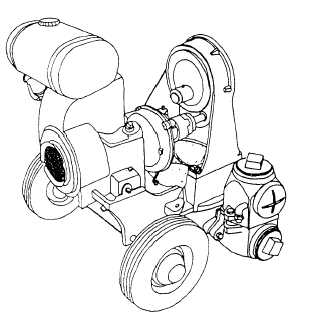Figure 14-33.—Diaphragm pump.
unseat (and at the same time keeps the discharge ball
valve seated) and to admit liquid to the pump cylinder.
On the discharge stroke, the diaphragm is pushed
downward forcing the trapped liquid out through the
discharge valve. Thus the liquid is made to move by the
reciprocating motion of a flexible diaphragm.
Since the diaphragm forms a tight seal in the pump
cylinder between the liquid being pumped and the rest
of the pump and driving mechanisms, there is little
danger of liquid abrasion or corrosion of moving parts
behind the diaphragm.
NOTE: Diaphragm pumps are especially
well-suited for pumping mud, slime, silt, and other
wastes or heavy liquids containing debris, such as sticks,
stones, or rags.
Liquid strainers are fitted at the suction inlet to
prevent large objects from fouling the suction and
discharge valves or possibly damaging the diaphragm.
You may have to use the diaphragm pump for such
duties as dewatering trenches where sewer lines or
waterlines are to be laid, dewatering cofferdams or
cave-ins, or repairing breaks in water or sewage lines.
Two of the most popular types of diaphragm pumps are
the mud hog (closed discharge) and the water hog
(open discharge).
The mud hog is for jobs that require pumping heavy
and thick liquids that must be discharged at a distance
away from the pump. The pump is fitted with discharge
hose connctions, and the ball valves and chambers are
designed to prevent fouling by sticks, stones, or rags.
The water hog is used for pumping thinner or less
viscous liquids. It can handle liquids containing sand,
gravel, or mud. The discharge outlet from the water hog
is open to permit free flow and to increase discharge
capacity. The liquid is discharged directly at the pump.
A discharge hose, however, can be fitted to the pump if
desired, but the hose connection can reduce the
efficiency of the pump.
You must know the operation of the diaphragm
pump. Since nearly every job presents a different
problem, you may have to vary the operating procedure
to fit the individual job.
Before starting the pump, place the suction line and
screen in the liquid to be removed by the pump.
Construct a trough to drain the pump discharge away
from the pump.
OPERATION.— Start the engine first. If the pump
does not pick up the liquid in a minute or two, check the
suction line for leaks. You can do this by pouring water
over the hose connections. In the event there is a leak,
air bubbles will appear.
Should the connections be tight and no leaks appear,
check the diaphragm for cracks or punctures. If the
diaphragm is damaged, it has to be replaced. A
mechanic inspector must make any further inspections.
INSPECTION.— Because of the nature of the
liquids handled by diaphragm pumps, inspection during
pump operation becomes particularly important.
Inspect the suction inlet strainer often to avoid
accumulations of debris that reduce suction efficiency.
Most diaphragm pump installations also permit easy
access to the suction and discharge ball check valves.
These valve mechanisms should also be inspected
frequently to detect scoring, fouling, and improper valve
seating.
NOTE: Sand, gravel, and other material can
corrode the diaphragm and ball check valves; expect
these parts to require the most frequent operator
inspections.
Centrifugal Pump
The basic centrifugal pump has only one moving
part: a wheel or impeller that is connected to the drive
shaft of a prime mover and that rotates within the pump
casing. The impeller is designed to impart a whirling or
revolving motion to the liquid in the pump. When the
impeller rotates at relatively high speeds, sufficient
14-29



